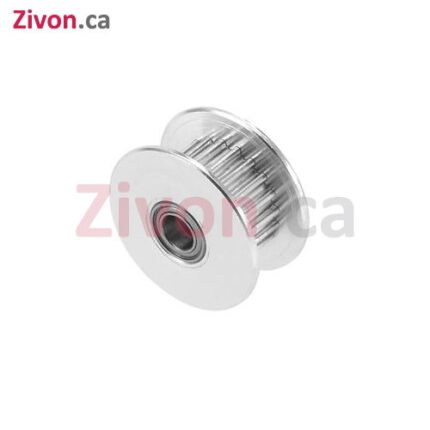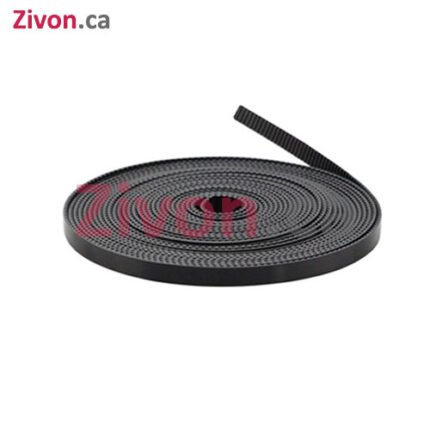Timing Belt
One of the ways of mechanical motion transmission and force transmission used in various industrial applications is pulleys and belts. The simplest type of pulley consists of a grooved ring with a V-shaped or O-shaped cross-section or a flat ring, which is usually used with rubber belts to transfer power from the motor to the load. In various industrial applications such as water coolers, radiator fan blades of old cars, and many other cases, this type of pulley and belt is used. One of the advantages of this method is the affordability of pulleys and belts. However, a major drawback of this method is the slipping of the belt on the pulley under high pressure or heating and loosening of the belt.
Therefore, when installing the belt, it should be tightly tensioned to reduce the likelihood of slipping, which in turn puts excessive pressure on the bearings and reduces their lifespan. The power transmission coefficient in this model is usually low (around 50%) and depends on the tension of the timing belt on the timing pulley and the friction coefficient between the pulley and the belt.
However, this drawback is sometimes perceived positively when this slipping acts as a mechanical fuse or clutch and prevents the device from gripping when overloaded. In applications where the speed ratio between the motor and the load needs to be fully maintained and the power transmission coefficient needs to be maximized, timing belts and pulleys are used.
Timing belts and pulleys are a type of belt and pulley that use teeth instead of relying on friction for motion transmission. Timing pulleys and timing belts are made with toothed shapes and various tooth pitches, similar to chains and sprockets, and create a constant ratio between the motor and the load, with a power transmission coefficient close to 100%.
Due to their higher efficiency compared to ordinary belts, timing belts, and pulleys require less width for transmitting similar power. Moreover, the tensioning of timing belts does not need to be as tight as V-belts, so there is less pressure on the bearings.
10 Advantages of Timing Belts and Pulleys Compared to Sprockets and Chains
Some advantages of timing pulleys and belts compared to gears and chains are as follows:
- No need for oiling or greasing, so they operate dry and clean, making maintenance easier.
- Much lighter than gears and chains, so in applications where the number of starts and stops per minute is high (e.g., 200 revolutions per minute), less current is drawn from the motor, and less pressure is applied to the motor.
- The overall weight of the device is lighter. Even in some applications, aluminum pulleys can be used to further reduce weight.
- Due to their lower inertia compared to gears and chains, they allow for faster acceleration and better dynamics.
- The backlash between the pulleys and belts in timing pulleys and belts is much less than in gears and chains. In HTD models, which include 3M, 5M, 8M, and 14M types, backlash can be reduced to a fractional degree.
- The allowable movement speed for power transmission is much higher than that of chains. In some models of timing belts, the rotation speed of the smaller pulley may be around 8000 rpm.
- The noise and sound pollution generated during operation are much less than gears and chains.
- Due to the finer pitch of the teeth compared to gears and chains, it is more practical to create different ratios between two pulleys.
- Depending on the material of the belt, which is non-metallic, working in environments that create corrosion for metals is not a problem.
- Both pulleys and belts are available in various widths. Therefore, there is more flexibility in selecting components when designing a system.
Types of Timing Belts and Pulleys
There are timing belts and pulleys with metric pitch and circular tooth shapes called the M series (including 2M, 3M, 5M, 8M, 14M, and 20M). GT2 belts and pulleys, which stand for Gates Tooth, are also of the metric pitch and semi-circular tooth shape variety. GT2 belts are stronger than HTD belts, but to make the most of their power, you should mount them on GT2 pulleys.
There are timing belts and pulleys with metric pitch and trapezoidal tooth shapes and a flat head, which include the T series (including T2.5, T5, T10, and T20) and AT series (including AT5, AT10, and AT20) and SM series (including S2M, S3M, S4.5M, S5M, S8M, and S14M).
There are timing belts and pulleys with inch pitch and trapezoidal tooth shapes, including the MXL, XL, XH, L, and H series.
Metric timing belts are cut in one piece and are delivered complete and without cutting in any length ordered.












